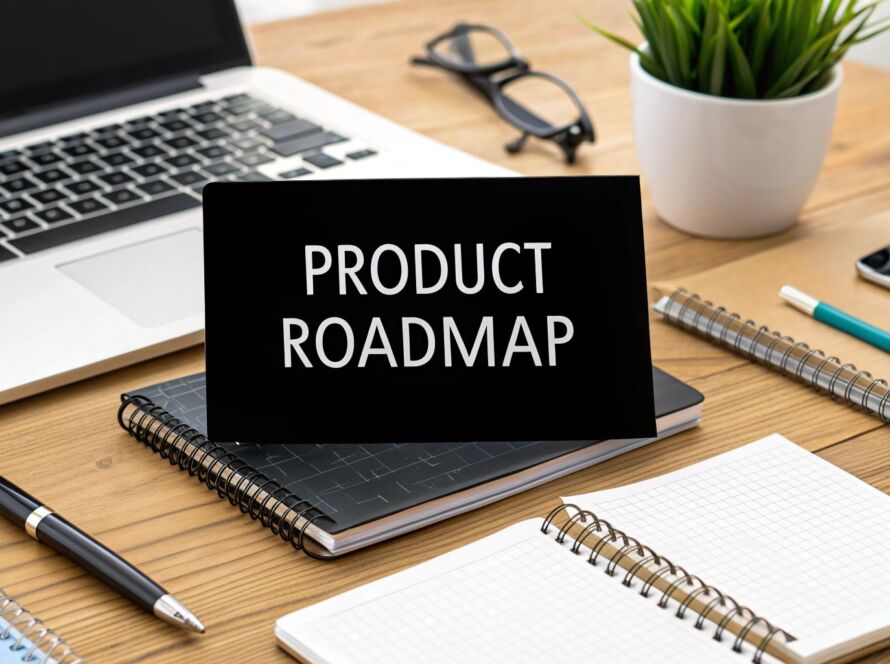Building Your Foundation: Core Elements of Product Strategy

Creating a solid product strategy is like building a house – you need a strong foundation before anything else. Success depends on understanding not just what you want to build, but why you're building it, how you'll do it, and who it's for. Let's explore the key building blocks that make up an effective product strategy.
Defining Your Product Vision and Mission
At the heart of every successful product is a clear vision and mission. Your vision sets the destination – it's the big picture of what impact you want your product to make. Think about how your product could meaningfully improve people's lives. For example, your vision might be "to empower individuals to effortlessly manage their finances." From there, your mission explains the path you'll take to achieve that vision. Following our example, the mission could be "to create user-friendly financial tools accessible to everyone." When your team shares a common vision and mission, they can work together with purpose and clarity.
Understanding Your Target Audience
Just as a builder needs to understand the ground they're building on, you need deep insight into your target audience. Go beyond basic facts like age and location – what keeps them up at night? What frustrates them about current solutions? What would make their lives easier? For instance, if you're building project management software, spend time with project managers to learn their daily challenges. Maybe they're juggling too many tools or struggling with team communication. This firsthand knowledge helps you create something they'll truly value.
Setting SMART Goals and KPIs
With your foundation in place, it's time to create clear goals and ways to measure success. Your goals should be Specific, Measurable, Achievable, Relevant, and Time-bound (SMART). Rather than saying "we want more users," set a concrete goal like "increase daily active users by 15% this quarter." Then choose Key Performance Indicators (KPIs) that track your progress, such as daily active users, how long people use your product, and which features they use most. These metrics tell you what's working and what needs improvement.
Embracing the Product Life Cycle
Products, like buildings, go through distinct phases – introduction, growth, maturity, and decline. Each stage needs its own approach. When you first launch, focus on finding early adopters and gathering feedback. As you grow, shift gears to reach more customers and improve your product based on what you've learned. Understanding these stages helps you make smart choices about where to invest your time and resources. Stay flexible and ready to adapt as your product evolves and market needs change. This dynamic approach keeps your product relevant and valuable over time.
Transforming Customer Insights Into Strategic Gold

Success in product strategy starts with truly knowing your customers – not just surface-level facts, but their real-world challenges, desires, and unspoken needs. When you deeply understand what drives your customers, you can build solutions that genuinely serve them. Let's explore how to turn customer understanding into concrete strategic advantages.
Gathering the Gold: Effective Customer Research Methods
Great customer research forms the foundation of any strong product strategy. The key is using multiple complementary research methods to build a complete picture. Surveys help map broad trends across your customer base, while one-on-one interviews reveal nuanced insights about individual experiences. Watching real users interact with your product through testing sessions shows you exactly where they get stuck or delighted. This varied approach helps you see the full scope of customer needs.
Refining the Ore: Analyzing and Interpreting Customer Feedback
Once you've gathered customer feedback, the magic happens in making sense of it all. Look for common themes that keep emerging in customer comments. Try to understand the "why" behind customer behaviors – what's really driving their actions and choices? For example, if multiple customers mention struggling with a specific feature, dig deeper to uncover the root cause. This analysis turns raw feedback into practical insights you can act on.
Shaping the Gold: Building Actionable User Personas
User personas bring your customer research to life by creating realistic representations of your ideal users. The best personas go far beyond basic demographics to capture the human elements – what frustrates them at work, what goals drive them, and what solutions they've already tried. For instance, rather than just noting "marketing manager," detail their typical workday challenges and what success looks like for them. These rich personas help teams make decisions that truly serve real users.
Striking the Balance: Aligning Customer Needs with Business Objectives
While customers come first, your product strategy also needs to support business growth. The sweet spot is finding ways to meet customer needs that also advance company goals. For example, when customers ask for a simpler interface, that aligns perfectly with the business goal of higher engagement and retention. Stay flexible and keep testing your assumptions as both customer needs and business priorities evolve. Regular check-ins with customers help ensure you're still solving the right problems in the right ways.
Navigating Product Life Cycles With Strategic Precision
Every successful product moves through clear stages of growth, just like any living thing. Understanding these stages – from first launch through maturity and beyond – is essential for making the right moves at the right time. With a thoughtful strategy framework as your guide, you can skillfully steer your product through each phase of its journey.
Introduction Stage: Launching With Impact
When your product first enters the market, sales typically start slow as people discover what you offer. This early stage is all about building awareness and helping potential customers understand your product's unique value. Smart marketing becomes crucial – think targeted ads, helpful content, and PR outreach to gain initial momentum. For instance, new software products often offer free trials to attract early users and generate positive word-of-mouth. Your main goal should be establishing a strong foothold with your target audience through clear communication and engagement.
Growth Stage: Scaling for Success
Once your product gains real traction, you'll see sales climbing rapidly along with your market share. This exciting phase requires focusing on scaling up operations smoothly while maintaining quality. Building strong customer relationships becomes even more vital. That software product we mentioned might now invest heavily in excellent support and onboarding to keep users happy and coming back. You may also spot opportunities to reach new customer segments or create product variations to serve different needs.
Maturity Stage: Maintaining Momentum
As the market becomes saturated, sales growth naturally slows and competition heats up. Now is the time to focus on standing out through smart innovation and exceptional service. Consider adding valuable new features, improving core functions, or testing different pricing approaches to stay competitive. Our example software might add premium capabilities or connect with popular platforms users already love. The key is maximizing profitability while protecting your market position through continuous improvement.
Decline Stage: Adapting or Reinventing
When sales begin declining, it's decision time – but this doesn't have to mean the end. With strategic thinking, you can adapt to changing market conditions. This might mean reducing costs, streamlining operations, or thoughtfully transitioning away from the product. Or, you might completely reinvent it for new uses or markets. Perhaps that software could evolve into a cloud solution or find new life serving a specialized niche.
By deeply understanding these natural stages and staying flexible in your approach, you can guide your product to long-term success. The key is staying close to your market through constant analysis and customer feedback, then adjusting course as needed. This forward-thinking mindset helps extend your product's impact while building lasting market strength.
Creating Cross-Functional Alignment That Sticks

The real value of a product strategy lies in how it brings teams together. When engineering, marketing, sales, and customer support all work as one, magic happens. But getting there takes more than just good intentions. Take the case of a software company building a new project management tool – if marketing promotes features that aren't ready yet, customers get frustrated. Let's explore how successful product leaders build and maintain this essential team harmony.
Managing Stakeholder Expectations
Each team brings their own perspective to the table. Sales teams focus on closing deals, while engineering teams prioritize building solid technical foundations. As a product manager, your role is to be the bridge – helping everyone see how their work fits into the bigger picture. This means clearly sharing the product roadmap, setting goals that resonate with all teams, and stepping in early when priorities clash.
Coordinating Across Departments
Great teamwork needs more than just good communication – it needs smart systems that keep everyone in sync. Regular cross-team meetings create natural touchpoints, while shared documentation ensures everyone works from the same playbook. For example, when teams use the same project management tool, marketing can see exactly when features will be ready and plan their launches accordingly. These connections help teams move faster and work smarter together.
Maintaining Strategic Consistency While Allowing for Tactical Flexibility
The best product strategies are like strong roots that allow branches to grow and adapt. While the core vision stays steady, teams need room to adjust their approach based on what they learn. Marketing might refine their message after hearing customer feedback, or engineering might prioritize fixing bugs over adding new features. This balance helps products stay true to their purpose while remaining responsive to real market needs.
Regular strategy reviews keep teams aligned as markets shift and change. Including voices from all departments ensures the strategy stays grounded in reality for everyone involved. Taking time to celebrate shared wins reinforces the value of collaboration and inspires teams to keep pushing forward together. By nurturing this culture of shared success and continuous growth, product leaders create partnerships that stand the test of time and drive lasting results.
Measuring What Matters: Data-Driven Strategy Evolution
Every successful product strategy needs constant refinement based on real data and market feedback. Like a skilled navigator who adjusts their course based on weather conditions and currents, product leaders must continually fine-tune their approach using concrete performance metrics and customer insights.
Establishing Meaningful Metrics
The foundation of smart decision-making starts with picking the right metrics to track. Your metrics should connect directly to your core strategic goals. For instance, if you aim to boost engagement, focus on daily active users, time spent in your product, and how often people use key features. If growth is your priority, keep a close eye on conversion rates, what it costs to acquire customers, and their lifetime value. This focused approach ensures you're tracking what genuinely drives success.
Creating Effective Feedback Loops
Simply gathering data isn't enough – you need structured ways to turn that information into concrete improvements. This means building systems that capture both hard numbers (like usage stats) and customer perspectives (through reviews and surveys). For example, adding feedback tools right into your product lets you understand user experiences in real-time. Regular customer check-ins through surveys help uncover deeper needs and pain points. These feedback channels provide the raw material needed to keep improving your strategy.
The Art of the Strategy Review
Regular strategy check-ins, typically monthly or quarterly, are essential for keeping your product on track. These sessions bring together people from across teams – engineering, marketing, sales, and support – to analyze performance data, spot emerging patterns, and make course corrections. Just as a pilot needs to regularly check their instruments and adjust for changing conditions, these reviews help product teams adapt to shifts in the market landscape.
Pivoting Without Disruption
Sometimes the data shows you need to make bigger changes to your strategy. But pivoting doesn't mean starting from scratch. Instead, it means thoughtfully adjusting your approach based on what you've learned. For instance, a software company might switch from subscriptions to a freemium model after seeing how customers actually use their product. The key is planning these shifts carefully and communicating openly to keep development smooth and teams aligned. Think of it like changing lanes on the highway – you're still heading to the same destination, just taking a slightly different path.
Tools and Techniques for Tracking Progress
Teams today have access to many tools to support data-driven decisions. Google Analytics helps track user behavior and product performance. A/B testing platforms let you experiment with different features to boost engagement. Project management software helps coordinate work across teams and track key milestones. By thoughtfully using these tools as part of your strategy, you can make smarter choices based on real evidence rather than guesswork. This continuous improvement cycle is crucial for building products that don't just meet current needs but stay ahead of where the market is going.
Scaling Your Product Strategy Framework

As your business grows, your product strategy framework needs to grow with it. Success depends on skillfully adapting your approach across multiple products, teams, and markets. Let's explore practical ways to scale your framework effectively while maintaining its core strengths.
Maintaining Consistency Across Products and Teams
Think of your product strategy framework like a franchise – while each location has its own personality, the core brand and offering stay consistent. Creating a central product strategy playbook helps teams stay aligned on key principles and direction. This living document evolves as you learn and markets change, but provides the stable foundation teams need. Regular updates ensure it stays relevant while preserving what works.
Adapting to Different Markets and Contexts
While consistency matters, your framework must flex to meet distinct market needs. A software product may need different features or localization to connect with users in various countries. Build guidelines that empower teams to adapt thoughtfully while staying true to your strategic vision. The key is finding the right balance between standardization and customization.
Training and Documentation: Empowering Your Teams
For your framework to scale successfully, teams need clear guidance on how to apply it. Develop thorough training that covers core principles, practical implementation, and links to business goals. Create accessible documentation that serves as a shared reference, like a user manual for your framework. When everyone understands both the what and the why, they can move forward confidently.
Building Scalable Decision-Making Frameworks
Clear processes become even more important as teams expand. Create structured approaches for making choices within your framework. Define who owns what decisions, establish paths for handling complex issues, and set clear evaluation criteria. Tools like a RACI matrix help specify roles and keep everyone coordinated without bottlenecks.
Practical Examples and Pitfalls to Avoid
Look at how successful companies scale their frameworks – for instance, how Google expanded its core search into integrated services for different needs while maintaining strategic alignment. Learn from common challenges like over-centralizing control, poor communication between teams, or inadequate training. Being aware of potential pitfalls helps you proactively address them.
Ready to turn your vision into reality? MarkBox Studios helps founders develop MVPs and create solutions that grow. From regular startup insights to personalized guidance, we support entrepreneurs in reaching their goals. Contact us today to explore how we can help you build and scale your product for lasting success.



